Henry Hatsworth & Hybrid Games
 Monday, April 13, 2009 at 9:20AM
Monday, April 13, 2009 at 9:20AM Henry Hatsworth is an excellent game to illustrate the relationship between depth and complexity. Being a hybrid game, HH is basically two wholly different games played at once. This core design automatically makes HH a game with at least the complexities of two games but not necessarily the depth. In classic DS fashion, the action/platformer is on the top screen and the planet puzzle league like puzzle game is on the bottom, touch screen.
TOP GAME
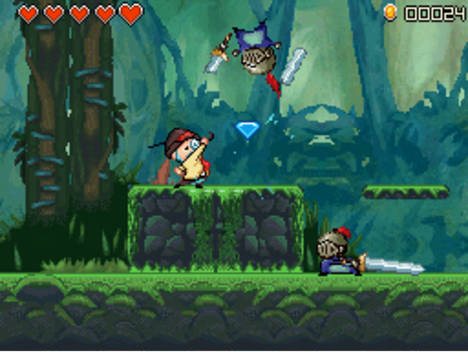
It is not uncommon for hybrid games to focus on one game as the primary game and design the other to provide some interesting cross over effects, dynamics and/or support. In HH, the top screen is the primary game displaying the game world and the bottom screen is the more abstract puzzle realm that supports the top and adds an interesting dynamic.
On the top screen Henry's main goal is to simply get to the end of the level whether that means overcoming platforming challenges, battling enemies, or dispensing with bosses.
Depth:
- Natural counters of combat. Players can dodge around and move into position to attack enemies.
- Decay counter of ammunition. The power meter on the side is consumed with every shot players launch.
- Abstract counters. Activating some special attacks makes Henry invincible for the duration of the attack animation.
Complexities
- several kinds of enemies.
- several kinds of level elements
- several kinds of powerups and items.
- several different kinds and combinations of attacks
- features a simple hit stun/combo system that can be reduced to one combination that nearly fits all enemies in all situations.
BOTTOM GAME
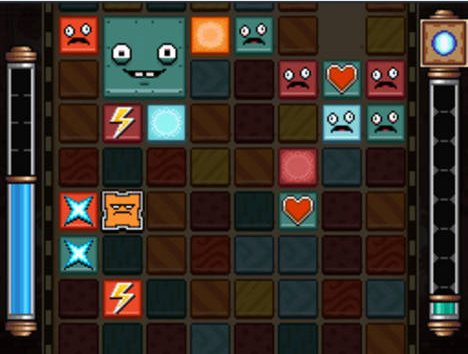
The bottom screen is at its core a copy of the planet puzzle league (Pokemon Puzzle League/Tetris Attack/Panel de Pon) puzzle game design. In this game, players can only shift blocks around horizontally. The blocks can also fall due to gravity. When 3 or more blocks of the same color are aligned in a straight line, they are cleared leaving a hole where they once where. With either careful planning, quick moves, or a combination, players can create chain reactions where the blocks that fall into the gaps created by cleared blocks in turn create more matches that clear blocks. Repeating this cycle as long as possible can be quite a challenge. Unlike the planet puzzle league design, in HH when the normal colored blocks reach the top of the screen, the game isn't over. They are simply pushed off the screen never to return.
Depth
- The primary source of contrary motion is against the clock, an organic timer created from the blocks that constantly rise up from the bottom of the screen. To counteract the rising blocks, player must make matches and/or rearrange the blocks. With every match, the rising timer is paused for a brief period of time.
- For every block you move, space is negotiated in a push-pull interplay relationship.
- In HH, there are a variety of different enemy blocks that require special counter moves to be cleared. Some are large 2x2 blocks that break up into smaller blocks. Some are lock blocks that cannot be moved.
Complexities
- The variety of normal, item, health, energy, and enemy blocks.
- The comparitive values of each each type of chain (2x, 3x, etc.) and each size of pair (3, 4, 5 blocks).
THE CROSS GAME
When adventuring with Henry, there are a lot of designed features that keep players switching between both games. Keep in mind that the bottom screen is always rising up no matter what screen you're playing on, and time on the top screen freezes when playing on the bottom screen.
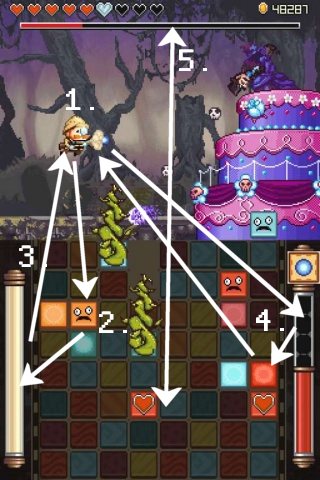
- As you progress through a level, it's only natural to kill enemies along the way. Attacking enemies is often the safest way to progress through a level. Also, hit/comboed enemies drop gems that are functionally like experience points. Even if you're a pacifist player, the arena style battle rooms force you to kill. Every enemy you kill turns into a special enemy block on the bottom screen.
- When non-enemy blocks reach the top of the puzzle screen, they disappear forever without any harmful or threatening consequences. When enemy block reach the top of the puzzle screen, they are reinserted back into the top screen action game world and attempt to do more harm to the player in "beyond the grave" fashion. To prevent this from happening, players must get rid of enemy blocks on the bottom screen by matching them up before the reach the top.
- As you work at matching up blocks on the bottom screen, if you take too long, the timer on the left side will run out and kick you back out (or should I say up) to the top adventure screen. To gain more time to puzzle solve on the bottom screen, players must hit enemies. This design feature creates a cross game close loop of interplay around combat and puzzle solving (each game's primary functions).
- The projectile attacks in HH have limited ammo. The energy meter at the right side of the screen is consumed with every shot. Also, players can execute special super attacks that significantly drain the power meter. To replenish the power meter, players must make matches and chains on the bottom screen. However, the most effective and practical way of replenishing the meter is by making matches out of the enemy/energy blocks. So, to continually use the safer more powerful projectile attacks, players have to do a lot of killing and puzzle solving. This design feature creates yet another interplay loop that's dependant on enemies.
- To recover one's health or to activate powerups, players have to make matches on the puzzle screen with special heart/powerup blocks. These blocks either randomly appear on the bottom screen or players can find them on the top screen at which point they fall to a random place on the puzzle screen. Because the blocks on the bottom screen are constantly rising, these useful powerups can be pushed off the top of the screen and lost forever while you're playing on the top screen. Also, when attempting to make matches out of these blocks, if you don't have enough of the right colors, you won't be able to activate them. On top of this, you can't make the blocks on the puzzle screen rise any faster than they do. So when you're out of blocks, you have to either wait on the bottom screen, which burns time, or you can wait on the top screen, which can be very dangerous depending on the circumstances. In this way, the puzzle screen functions as a dynamic item inventory with upkeep and cross game interplay.
- Finally, to transform into the invincible all powerful robot, players must completely fill up the power meter twice over. To do so, players most likely have to use their projectiles very carefully or not at all to conserve energy. By hitting/comboing enemies far past the point of death (overkills) players can generate useful energy blocks on the bottom screen instead of enemy blocks. Whenever players ejects from the robot suit or the robot timer runs out, the power meter is drained and the process starts all over again.
The design of Henry Hatsworth forces and encourages players to work back and forth between both games/screens. Unfortunately, a lot of the depth in the cross game relies on abstract mechanics and design features. This in turn creates a lot of complexities around gameplay that's relatively simple. Perhaps using a lot of abstractions in the cross design is inevitable when creating a hybrid game between an action game and a puzzle game.
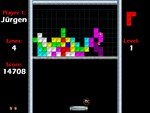 Breakris (play it here) is perhaps too complicated because players play both action based games simultaneously. On the positive side, the dynamics between both game systems are bound by the same dynamics of space. In other words, both games interact with each other by existing in the same "room." Another interesting dynamic is how the Breakout mechanics work to remove blocks while the Tetris mechanics work to build them up and occasionally remove them.
Breakris (play it here) is perhaps too complicated because players play both action based games simultaneously. On the positive side, the dynamics between both game systems are bound by the same dynamics of space. In other words, both games interact with each other by existing in the same "room." Another interesting dynamic is how the Breakout mechanics work to remove blocks while the Tetris mechanics work to build them up and occasionally remove them.
The World Ends With You, though not a hybrid game, also tried to create gameplay across two battles/screens at once. Like Breakris playing two games at once that require your focused attention and gaze is too complicated. Instead of smoothly playing both at once, I found that my attention shifting rapidly between the two games or that it was divided across both games (a very inefficient approach).
Like Henry Hatsworth, Advance Wars Dual Strike (not a hybrid game) balanced out the hybrid style gameplay by only giving the player control of one screen at a time. AW:DS is a turned based game, so players are never pressured by time. Also like in HH, in the dual screen battles, one battle is the primary front and the other battle is secondary. To win everything, the player only has to achieve victory on the primary front. If either player manages to win the secondary front before the battle on the primary front is over, that player receives a significant power bonus.
In the end, Henry Hatsworth is a unique and interesting game with a lot of poor, abstract, and complex design elements/choices woven together. A little design goes a long way especially when you invest in interplay. Simply progressing through the levels and playing to the intersecting interplay cycles was enough to keep me engaged throughout most of the game. Still, for the amount of interesting cross game interplay, there are a lot of complexities and underutilized gameplay elements. For these reasons Henry Hatsworth is a game that I have mixed feelings about, but despite its flaws, I approve of.
 Action,
Action,  Advance Wars,
Advance Wars,  Planet Puzzle League,
Planet Puzzle League,  Tetris in
Tetris in  Dynamics,
Dynamics,  Review |
Review |  Permalink |
Permalink |  Print Article
Print Article 

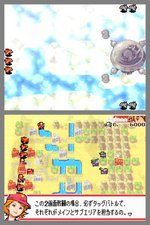
Reader Comments (1)
nice website